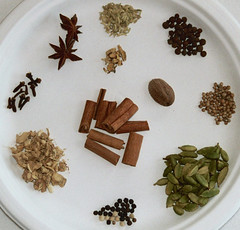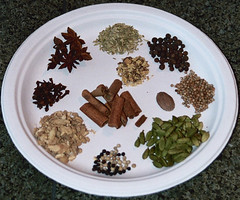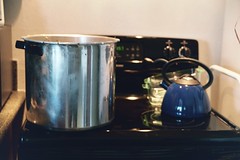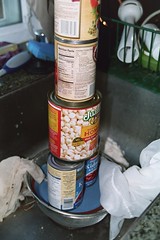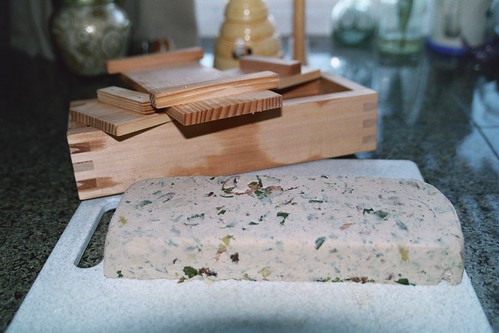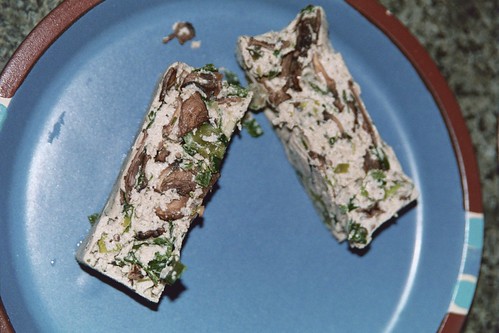The cupboards are growing bare. This is a GOOD thing. Moving – and planning to live off only what you have in your cabinets (like many people try and knit off of their “stash”) has been an exercise in creativity. We are not big warehouse-market people (which is why living in the UK might be easier for us than some), but we do tend to have a lot of “staples” around – the usual things that settlers carried in wagons going West: flour, oats, and beans. We also had an unprecedented amount of cornmeal.
I’d say I don’t know how that happened, but that would be a falsehood most dire. It happened because Himself is …er, shall we say Observationally Challenged, and tends to buy things he needs for a recipe, regardless of whether or not said recipe item is already present in the pantry. If a recipe calls for cornmeal? We have polenta, finely ground white cornmeal, grits, and regular yellow cornmeal. AND corn tortilla “breadcrumbs.” I have been endeavoring to use these odds and ends, together with fresh stuff from the farmer’s market, to create enticing meals. The success rate thus far has been …mixed.
Sure, sure, I can make polenta. I can use the cornmeal to thicken soups, etc. I can use the tortilla crumbs to bread tofu. But I said ‘enticing’ meals, right? We are SO BORED not being able to have the full range of our kitchen available to us. We are also SO TIRED at the end of packing, cleaning, selling and other ‘-ings,’ so we really need healthy comfort-food.
Years ago when we lived in the North Bay Area (Yay, Santa Rosa!), our market had a large Indian section, and I learned the joy that is chana-battered onions, baked. (We had them served deep fried at an Indian restaurant, onion bhajji, and they are evilly addictive — so, baked it is.) Now, this flour you may know by other names but chickpea flour = besan (flour) = gram flour = cici flour = chana dal or dal flour = garbanzo bean flour – (it’s all about the same thing, though I am by no means an expert and would urge you to ask a friend from the Southern part of Asia.), and after years of using this flour for various things, I found that I had about four cups left. Four cups of chana flour… acres of cornmeal… Sounded like cornbread to me.
I layered a healthy sausage alternative on the bottom of the pan, mixed fresh corn from our leftover corn-on-the-cob meal (eaten before I looked in the cabinet and gaped at the surfeit of maize), with sweet onions and topped it with the chana flour and cornmeal bread, and voilà! It was really TASTY, and surprisingly light. No measurements were involved (I am down to a single plastic measuring cup, no spoons, even), but I have a smidge more of the crucial ingredients (and baking powder!), and I hope to reproduce this one on the weekend.
So heady was my savory cornbread experience, I rushed to create another one in a sweeter form. The first difference is that I believe measuring matters when using finely ground white cornmeal. It’s not like polenta, where you can fudge it and bodge in a few more cups of water or meal as needed. Fine-ground cornmeal is oddly like… sand. It doesn’t seem like it’s all that wet, or dry, until suddenly it… is. At first the batter was too wet. I added more cornmeal. From making grits, I should have known that was a bad idea.
Thought pretty and covered with two cans (We had six! What was he MAKING!?) of pineapple chunks and lovely currants, the Upside Down Polenta Cake had the density and moisture of a …brick. And thus we scraped off the tasty caramelized fruit, and drew a veil over the rest…
This is what I would make, if it weren’t so warm tonight:
Onion Bhajii Bake
2 cups chana flour
1 c. water
2 tsp. freshly ground cumin
1 tsp./pinch salt
1 tsp. ground chili peppers – optional
1/4 tsp. baking powder
2 large onions, sliced thinly
1 tbsp freshly chopped cilantro/coriander
1/3 c. olive oil to oil, plus sprayed oil, optional
Mix water and flour together with cumin and salt, baking powder and optional peppers to form a batter. Let it sit for a half hour so that your batter will be lighter. Oil a baking pan (I used a shallow cookie sheet), and set your oven to 400 degrees, or ‘High.’ Once the batter has fluff-ified, dredge your sliced onions into it, and place them in your oiled pan. I dusted ours with more cumin and chili pepper, spritzed them with oil, and baked them for 35, removing the pan halfway through to shake and turn the onions and spritz them again. Eat them with freshly chopped cilantro leaves or a spicy mango salsa. Yum. If only it weren’t too hot to bother with the oven. (In two or three weeks, I will remember saying this and laugh.)





